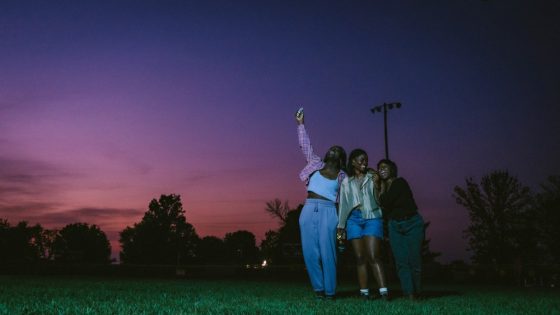“Dreams In Nightmares” starts from a very familiar place. Three friends go on a journey to search for a fourth, in the process discovering new truths about themselves. A main character even announces that they want “the quintessential American road trip.” But as the audience settles into what they think will be a story frequently told, Shatara Michelle Ford’s sophomore film reveals itself to be much more than that. The film, which premiered as the opening night presentation at Philadelphia’s Blackstar Film Festival, punctures those expectations to deliver something grander and more poetic.
A university professor and a business consultant who have recently been laid off from their respective jobs, Z (Denée Benton) and Tasha (Sasha Compère) are spending time together to cope with the unemployment blues. They join their friend Lauren (Dezi Bing), a poet who works odd jobs to make ends meet, on a trip to search for their missing pal Kel (Mars Storm Rucker). The four all met in college more than a decade ago, forming a strong friendship founded on a mutual love of art and a shared wish for a creative life. They are also all queer, though the film makes little fuss about that. They exist in different but equally complex situations: single and seeking love, in a warm, loving relationship, or a disintegrating, contentious one. Their identities are not limited by gender presentation or sexual orientation, even if they all have healthy carnal desires.
In crafting these characters, Ford explores what it means to be Black and queer in contemporary America. Though there are no loud proclamations nor obvious narrative complications, “Dreams in Nightmares” is at its core a political film. Danger is ever-present for these characters because of how they are seen, and how they present themselves. Yet Ford never falls into the trap of making that a plot contrivance. Rather, the film subverts expectations throughout by allowing its characters to exist, talk, eat, thrive, love and fuck.
That in itself is a political act, defying how a lot of American cinema has presented Black people before. Ford’s writing, along with their direction of the actors, brims with generosity towards all their characters — even ones presented as objects of ridicule are allowed grace notes. Some of their relationships come off as too perfect to be believable, yet they work within the context of this story as mirrors to what could be aspirational. Ford might be magnanimous in these portrayals but they are also sharply observant of familial and societal structures that constantly encroach on these characters’ joie de vivre. Presenting an idealistic contrast to that becomes necessary.
Benton grounds the film with a quiet performance rich in emotional clarity, her face registering a lot while remaining still. For long stretches of screen time, it’s the only thing seen in closeup: Whether worried on the phone, flirty in a bar or uncomfortable around a dinner table, she conjures a complete portrait. As the pragmatic Tasha, Compère plays comedy and utter desperation with equal aplomb, while on the opposite end of the spectrum, Rucker brings a bright personality and frame-filling warmth to Kel — the flighty dreamer of the quartet, so beguiling that the other three cannot help but be in their orbit. In a smaller role, Jasmin Savoy Brown enters as a hurricane hellbent on upending everyone’s life. Her character might be clueless but Brown is precise and uproariously funny.
The film’s humane writing is amplified by Ludovica Isidor’s glowing camerawork, while Ford’s filmmaking is a step up from their debut “Test Pattern.” The canvas is bigger, the rhythm slower yet more confident. This is a filmmaker in full command of their craft, demanding the audience follow their tempo. Thumping music conveys urgency, while languid camera movements capture details in the frame — techniques that might be expected but are still meaningful. Less conventionally, inserts of actors looking directly at the camera and fantastical interstitials add a dreamlike quality, making “Dreams in Nightmares” a singular artistic experience.
Ultimately, the film becomes a treatise on how to live a fulfilling life — one that is creative and artistic, built on supportive friendships and family. It is clear-eyed enough to present that as a quixotic goal, yet earnest enough to make it achievable. That may be hard to replicate in real life, but it’s wondrous to behold on screen.
Source Agencies


